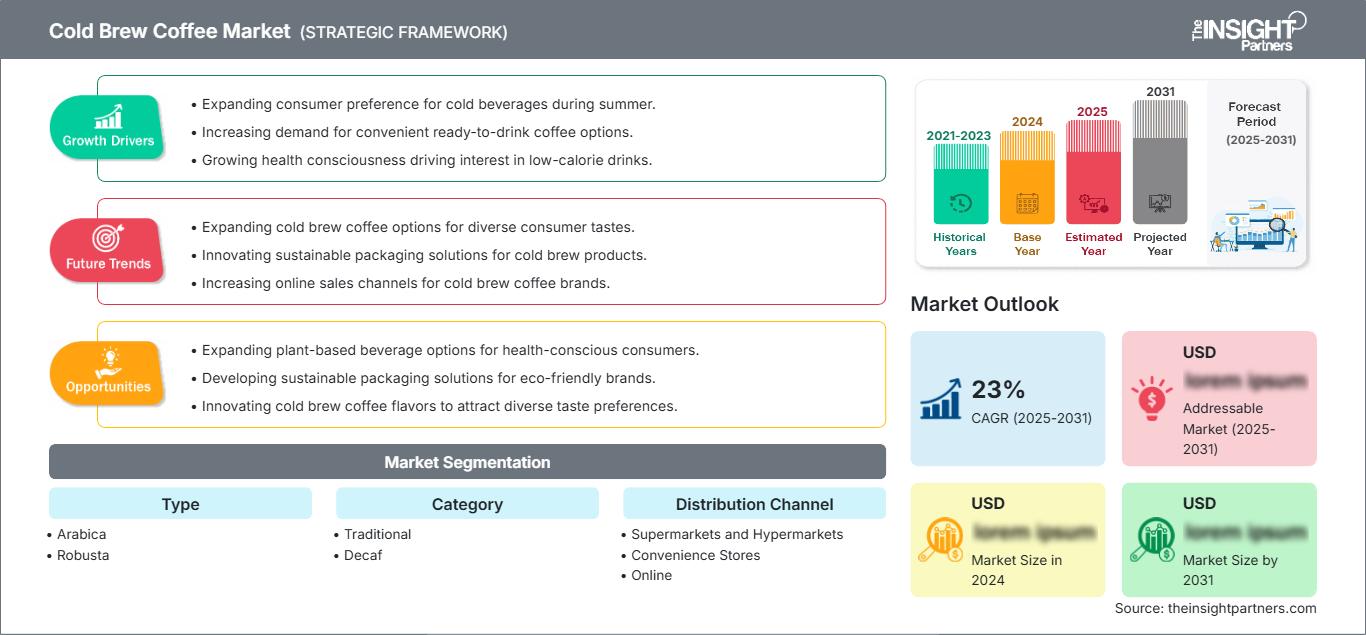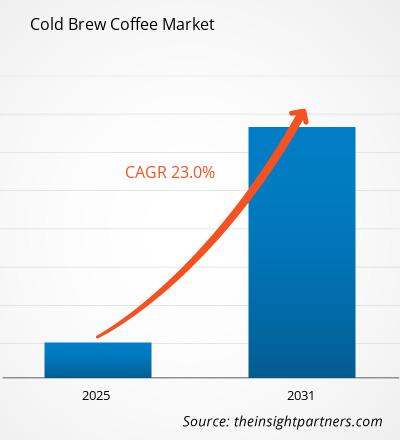Der Markt für Cold Brew Coffee wird zwischen 2023 und 2031 voraussichtlich eine durchschnittliche jährliche Wachstumsrate (CAGR) von 23 % verzeichnen. Der Konsum innovativer Kaffeearomen dürfte ein wichtiger Markttrend bleiben.
Marktanalyse für Cold Brew Coffee
Der Markt für Cold Brew Coffee erlebt ein starkes Wachstum, das von mehreren Trends angetrieben wird, wie beispielsweise der Bereitschaft der jungen Generation, neue Kaffeesorten und -aromen zu entdecken, die das Marktwachstum vorantreiben. Der immer hektischer werdende Lebensstil führt zu einer steigenden Nachfrage nach trinkfertigen Produkten, und Cold Brew Coffee erfüllt diese Kriterien. Darüber hinaus kurbeln das zunehmende Wissen der Verbraucher über Kaffeebohnen, die steigenden Ausgaben der Verbraucher für teurere Kaffeegetränke, die schnell wachsende Gesundheitssorge der Menschen und die steigende Beliebtheit von Cold Brew Coffee das Marktwachstum an. Darüber hinaus bieten die großen Anbieter kreative und neue Kaffeeprodukte an, die sich durch hochwertige Verpackungen und einzigartige Aromen auszeichnen.
Marktübersicht für Cold Brew Coffee
Cold Brew Coffee ist ein Getränk, das durch die Mischung von kaltem Wasser und gemahlenem Kaffee und anschließendes Ziehenlassen im Kühlschrank hergestellt wird. Beim Cold Brew-Extraktionsprozess werden verschiedene Verbindungen mit unterschiedlichen charakteristischen Aromen extrahiert. Im Vergleich zu heiß gebrühtem Kaffee, wie z. B. Americano oder Filterkaffee, ist Cold Brew Coffee milder, süßer und weniger säurehaltig. Außerdem wird beim Cold Brew-Prozess keine Hitze benötigt.
Passen Sie diesen Bericht Ihren Anforderungen an
Sie erhalten kostenlos Anpassungen an jedem Bericht, einschließlich Teilen dieses Berichts oder einer Analyse auf Länderebene, eines Excel-Datenpakets sowie tolle Angebote und Rabatte für Start-ups und Universitäten.
Markt für kalt gebrühten Kaffee: Strategische Einblicke

- Holen Sie sich die wichtigsten Markttrends aus diesem Bericht.Dieses KOSTENLOSE Beispiel umfasst Datenanalysen, die von Markttrends bis hin zu Schätzungen und Prognosen reichen.
Sie erhalten kostenlos Anpassungen an jedem Bericht, einschließlich Teilen dieses Berichts oder einer Analyse auf Länderebene, eines Excel-Datenpakets sowie tolle Angebote und Rabatte für Start-ups und Universitäten.
Markt für kalt gebrühten Kaffee: Strategische Einblicke

- Holen Sie sich die wichtigsten Markttrends aus diesem Bericht.Dieses KOSTENLOSE Beispiel umfasst Datenanalysen, die von Markttrends bis hin zu Schätzungen und Prognosen reichen.
Markttreiber und -chancen für Cold Brew Coffee
Steigende Beliebtheit von trinkfertigem Cold Brew Coffee
Die steigende Beliebtheit von trinkfertigem Cold Brew Coffee (RTD) entwickelt sich zu einem wichtigen Katalysator für die Expansion des globalen Marktes für Cold Brew Coffee. Die Attraktivität von RTD Cold Brew liegt in seiner einzigartigen Kombination aus Komfort, erstklassigem Geschmack und der Verbindung mit gesünderen Getränken, die zusammen eine starke Verbrauchernachfrage auslösen. In der heutigen schnelllebigen Zeit suchen Verbraucher zunehmend nach Getränken, die sowohl Qualität als auch sofortige Verfügbarkeit bieten. RTD Cold Brew Coffee erfüllt dieses Bedürfnis effektiv, indem er ein sanftes, vollmundiges Kaffeeerlebnis in einem praktischen, trinkfertigen Format bietet. Diese Bequemlichkeit ist besonders attraktiv für vielbeschäftigte Berufstätige, Pendler und Millennials, die einen schnellen und dennoch befriedigenden Koffeinschub benötigen, ohne Kompromisse bei Geschmack oder Qualität eingehen zu müssen. Führende Kaffeemarken und Getränkehersteller haben das Wachstumspotenzial dieses Segments erkannt und erweitern aktiv ihr Produktangebot. Verpackungsinnovationen – darunter recycelbare Materialien und unkonventionelle Behälterformate – steigern die Attraktivität von RTD-Cold-Brew-Produkten. Darüber hinaus erweitert die Produktdifferenzierung durch die Einführung neuer Geschmacksrichtungen, spezieller Kaffeemischungen und Sorten in limitierter Auflage die Auswahl für die Verbraucher und regt Wiederholungskäufe an. Auch die Vertriebskanäle entwickeln sich rasant, um dieser Nachfrage gerecht zu werden. RTD-Cold-Brew ist zunehmend in Convenience Stores, Supermärkten, Cafés und über Online-Plattformen erhältlich. Diese verbesserte Verfügbarkeit erleichtert die Erschließung neuer Märkte und Verbrauchersegmente. Darüber hinaus spielt der Trend zu gesundheitsbewussten Verbrauchern eine entscheidende Rolle beim Aufstieg von RTD-Cold-Brew. Der wahrgenommene geringere Säuregehalt und der weichere Geschmack im Vergleich zu herkömmlichem Heißkaffee sprechen Verbraucher an, denen Wohlbefinden und eine angenehme Verdauung wichtig sind. Diese Wahrnehmung, gepaart mit dem Trend zur Premiumisierung, ermutigt Verbraucher, von herkömmlichen Kaffeeformaten auf RTD-Cold-Brew-Produkte umzusteigen. Infolgedessen verzeichnet der Markt für RTD-Kaltbrühkaffee nicht nur ein beschleunigtes Umsatzwachstum, sondern erweitert auch seine Kundenbasis, indem er Kaffeeliebhaber und Gelegenheitstrinker gleichermaßen anzieht. Dieses dynamische Wachstum dürfte sich im Prognosezeitraum fortsetzen und die Position von RTD-Kaltbrühkaffee als wichtiges und schnell wachsendes Segment innerhalb der globalen Getränkeindustrie stärken.
Cold Brew wird immer beliebter gegenüber Eiskaffee
Die zunehmende Beliebtheit von Cold Brew gegenüber herkömmlichem Eiskaffee ist der Haupttreiber für den Markt für Cold Brew Kaffee. Cold Brew ist aufgrund seines weicheren und weniger säuerlichen Geschmacks im Vergleich zu konventionell gebrühtem heißem Kaffee eine attraktive Alternative zu herkömmlichem Kaffee. Kaffeekonsumenten wenden sich zunehmend von herkömmlichem Eiskaffee ab und bevorzugen Cold Brew-Produkte. Coffeeshops, Einzelhändler und Hersteller reagieren auf den Trend, indem sie ihr Angebot an Cold Brew-Segmenten erweitern, hybride oder rein natürliche Cold Brew-Varianten kreieren und neue Geschmacksrichtungen sowie trinkfertige Cold Brew-Optionen einführen, wie zum Beispiel MistoBox, Starbucks, Cold Brew von Panera Bread mit Eis sowie Ice Blended und Ice Pressed von Coffee Bean, beide kalt serviert, um nur einige zu nennen. Gesundheitsbewusste Verbraucher, darunter Millennials, entscheiden sich eher für Cold Brew, da dieser angeblich gesundheitsfördernd und handwerklich ansprechend ist. Da der Cold Brew-Trend anhält und der Markt wächst, werden Unternehmen, die in Ausrüstung und Marketing investieren, profitieren, indem sie einen Anteil am wachsenden Markt für Kaffee gewinnen, der sich in Richtung eines gewöhnungsbedürftigeren Geschmacks entwickelt.
Marktsegmentierung für Cold Brew Coffee
Der globale Markt für Cold Brew Coffee ist nach Typ, Kategorie und Vertriebskanal segmentiert.
- Basierend auf dem Typ ist der Markt für Cold Brew Coffee in Arabica, Robusta und andere unterteilt.
- Nach Kategorien ist der Markt in traditionellen und koffeinfreien Kaffee unterteilt.
- In Bezug auf die Vertriebskanäle ist der Markt in Supermärkte und Verbrauchermärkte, Convenience Stores, Online-Einzelhandel und andere segmentiert.
Marktanteilsanalyse für Cold Brew Coffee nach Geografie
Der Cold Brew Coffee Market Report umfasst eine detaillierte Analyse von fünf großen geografischen Regionen, die aktuelle und historische Marktgrößen sowie Prognosen für 2021 bis 2031, umfasst Nordamerika, Europa, Asien-Pazifik (APAC), den Nahen Osten und Afrika (MEA) sowie Süd- und Mittelamerika. Jede Region ist weiter in entsprechende Länder unterteilt. Dieser Bericht bietet Analysen und Prognosen für über 18 Länder und deckt die Marktdynamik von Cold Brew Coffee ab, darunter Treiber, Trends und Chancen, die die Märkte auf regionaler Ebene beeinflussen. Der Bericht umfasst außerdem Porters Fünf-Kräfte-Analyse, die die Untersuchung der wichtigsten Faktoren umfasst, die den Markt für Cold Brew Coffee in diesen Regionen beeinflussen.
Cold Brew Coffee MarktMarkt für kalt gebrühten Kaffee
Die Analysten von The Insight Partners haben die regionalen Trends und Faktoren, die den Markt für Cold Brew Coffee im Prognosezeitraum beeinflussen, ausführlich erläutert. In diesem Abschnitt werden auch die Marktsegmente und die geografische Lage von Cold Brew Coffee in Nordamerika, Europa, im asiatisch-pazifischen Raum, im Nahen Osten und Afrika sowie in Süd- und Mittelamerika erörtert.Umfang des Marktberichts zu kalt gebrühtem Kaffee
Berichtsattribut
Einzelheiten
Marktgröße in 2024
US$ XX million
Marktgröße nach 2031
US$ XX Million
Globale CAGR (2025 - 2031)
23%
Historische Daten
2021-2023
Prognosezeitraum
2025-2031
Abgedeckte Segmente
By Typ - Arabica
- Robusta
By Kategorie- Traditionell
- Entkoffeiniert
By Vertriebskanal- Supermärkte und Hypermärkte
- Convenience Stores
- Online
Abgedeckte Regionen und Länder
Nordamerika- USA
- Kanada
- Mexiko
Europa- Großbritannien
- Deutschland
- Frankreich
- Russland
- Italien
- Restliches Europa
Asien-Pazifik- China
- Indien
- Japan
- Australien
- Restlicher Asien-Pazifik
Süd- und Mittelamerika- Brasilien
- Argentinien
- Restliches Süd- und Mittelamerika
Naher Osten und Afrika- Südafrika
- Saudi-Arabien
- Vereinigte Arabische Emirate
- Restlicher Naher Osten und Afrika
Marktführer und wichtige Unternehmensprofile - Grady's Cold Brew
- Julius Meinl Industrie holding GmbH
- Red Thread Coffee Co
- RISE Brewing Co
- Sandows London Limited
- Starbucks Corporation
- Station Cold Brew Company
- Venice Cold Brew LLC
- Wandering Bear Coffee
- ZoZozial Coffee Roaster ApS
Dichte der Marktteilnehmer für Cold Brew Coffee: Verständnis ihrer Auswirkungen auf die Geschäftsdynamik
Markt für kalt gebrühten Kaffee
Die Analysten von The Insight Partners haben die regionalen Trends und Faktoren, die den Markt für Cold Brew Coffee im Prognosezeitraum beeinflussen, ausführlich erläutert. In diesem Abschnitt werden auch die Marktsegmente und die geografische Lage von Cold Brew Coffee in Nordamerika, Europa, im asiatisch-pazifischen Raum, im Nahen Osten und Afrika sowie in Süd- und Mittelamerika erörtert.Umfang des Marktberichts zu kalt gebrühtem Kaffee
| Berichtsattribut | Einzelheiten |
|---|---|
| Marktgröße in 2024 | US$ XX million |
| Marktgröße nach 2031 | US$ XX Million |
| Globale CAGR (2025 - 2031) | 23% |
| Historische Daten | 2021-2023 |
| Prognosezeitraum | 2025-2031 |
| Abgedeckte Segmente |
By Typ
|
| Abgedeckte Regionen und Länder | Nordamerika
|
| Marktführer und wichtige Unternehmensprofile |
|
Der Markt für Cold Brew Coffee wächst rasant. Die steigende Nachfrage der Endverbraucher ist auf Faktoren wie veränderte Verbraucherpräferenzen, technologische Fortschritte und ein stärkeres Bewusstsein für die Produktvorteile zurückzuführen. Mit der steigenden Nachfrage erweitern Unternehmen ihr Angebot, entwickeln Innovationen, um den Bedürfnissen der Verbraucher gerecht zu werden, und nutzen neue Trends, was das Marktwachstum weiter ankurbelt.

- Holen Sie sich die Markt für kalt gebrühten Kaffee Übersicht der wichtigsten Akteure
Neuigkeiten und aktuelle Entwicklungen zum Markt für kalt gebrühten Kaffee:
Der Markt für kalt gebrühten Kaffee wird durch die Erhebung qualitativer und quantitativer Daten nach Primär- und Sekundärforschung bewertet, die wichtige Unternehmenspublikationen, Verbandsdaten und Datenbanken umfasst. Einige Entwicklungen auf dem Markt für Innovationen, Geschäftserweiterung und Strategien sind:
- Bones Coffee Co. hat seine trinkfertigen (RTD) Cold Brew Lattes in fünf Geschmacksrichtungen eingeführt, darunter Sinn-O-Bun, French Toast, Holy Cannoli, S'morey Time und Electric Unicorn, die in Walmart-Filialen erhältlich sind. Die Lattes werden aus 100 % kalt gebrühtem Kaffee, Vollmilch und einer leichten Süße hergestellt und verwenden Arabica-Bohnen aus ethisch einwandfreiem brasilianischem Anbau. (Quelle: Bones Coffee Co, Newsletter, Juli 2023)
Bericht zum Markt für kalt gebrühten Kaffee: Abdeckung und Ergebnisse
Der „Markt für kalt gebrühten Kaffee: Größe und Prognose (2021–2031)“ bietet eine detaillierte Analyse des Marktes und deckt die folgenden Bereiche ab:
- Marktgröße und Prognose für Cold Brew Coffee auf globaler, regionaler und Länderebene für alle abgedeckten wichtigen Marktsegmente
- Markttrends und Marktdynamiken für Cold Brew Coffee wie Treiber, Einschränkungen und wichtige Chancen
- Detaillierte PEST/Porters Five Forces- und SWOT-Analyse
- Marktanalyse für Cold Brew Coffee mit wichtigen Markttrends, globalen und regionalen Rahmenbedingungen, wichtigen Akteuren, Vorschriften und aktuellen Marktentwicklungen
- Branchenlandschaft und Wettbewerbsanalyse mit Marktkonzentration, Heatmap-Analyse, prominenten Akteuren und aktuellen Entwicklungen auf dem Markt für Cold Brew Coffee
- Detaillierte Unternehmensprofile
- Historische Analyse (2 Jahre), Basisjahr, Prognose (7 Jahre) mit CAGR
- PEST- und SWOT-Analyse
- Marktgröße Wert/Volumen – Global, Regional, Land
- Branchen- und Wettbewerbslandschaft
- Excel-Datensatz
Aktuelle Berichte
Verwandte Berichte
Erfahrungsberichte
Grund zum Kauf
- Fundierte Entscheidungsfindung
- Marktdynamik verstehen
- Wettbewerbsanalyse
- Kundeneinblicke
- Marktprognosen
- Risikominimierung
- Strategische Planung
- Investitionsbegründung
- Identifizierung neuer Märkte
- Verbesserung von Marketingstrategien
- Steigerung der Betriebseffizienz
- Anpassung an regulatorische Trends




















 Kostenlose Probe anfordern für - Markt für kalt gebrühten Kaffee
Kostenlose Probe anfordern für - Markt für kalt gebrühten Kaffee